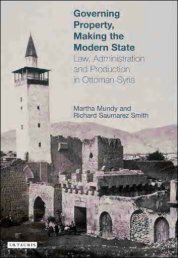Legal borrowing and its impact on Ottoman legal culture in ... - PSI424
Legal borrowing and its impact on Ottoman legal culture in ... - PSI424
Legal borrowing and its impact on Ottoman legal culture in ... - PSI424
Create successful ePaper yourself
Turn your PDF publications into a flip-book with our unique Google optimized e-Paper software.
AVI RUBIN<br />
<strong>in</strong>cluded exemplary cases <strong>in</strong>tended to guide judges <strong>in</strong> their daily work. 53<br />
Mard<strong>in</strong>’s observati<strong>on</strong> seems fairly reas<strong>on</strong>able. Though not backed by a<br />
specific reference to Cevdet’s writ<strong>in</strong>g, it reflects the fact that the reformers’<br />
ideology <str<strong>on</strong>g>and</str<strong>on</strong>g> policies were <strong>in</strong>spired by both Islamic-<strong>Ottoman</strong> <str<strong>on</strong>g>and</str<strong>on</strong>g><br />
C<strong>on</strong>t<strong>in</strong>ental <strong>legal</strong> traditi<strong>on</strong>s. After all, Cevdet Pas¸a’s greatest achievement,<br />
the civil code (the Mecelle), was an Islamic text based <strong>on</strong> the Shari’a. Once<br />
aga<strong>in</strong>, the syncretism <str<strong>on</strong>g>and</str<strong>on</strong>g> c<strong>on</strong>t<strong>in</strong>uity <strong>in</strong>herent <strong>in</strong> the practice of <strong>legal</strong><br />
<str<strong>on</strong>g>borrow<strong>in</strong>g</str<strong>on</strong>g> is apparent.<br />
When fram<strong>in</strong>g the discussi<strong>on</strong> <strong>in</strong> the thorny terms of <strong>legal</strong> <strong>culture</strong>, it is<br />
important to stress that almost all aspects of the <strong>Ottoman</strong> judicial sphere<br />
were <strong>in</strong> a c<strong>on</strong>stant state of dynamic transformati<strong>on</strong> throughout the ‘l<strong>on</strong>g<br />
n<strong>in</strong>eteenth century’, that is, up until the demise of the <strong>Ottoman</strong> state.<br />
Thus it is a <strong>legal</strong> <strong>culture</strong> <strong>in</strong> the mak<strong>in</strong>g that we are deal<strong>in</strong>g with rather than<br />
a deep-seated <strong>on</strong>e. It is clear that the discourse evident <strong>in</strong> the Ceride,<br />
discussed above, reflected the agenda of the reformers <str<strong>on</strong>g>and</str<strong>on</strong>g> ‘the state’ <strong>in</strong><br />
general, to use a somewhat reify<strong>in</strong>g term. Yet evaluati<strong>on</strong>s of <str<strong>on</strong>g>its</str<strong>on</strong>g> <str<strong>on</strong>g>impact</str<strong>on</strong>g> <strong>on</strong><br />
those many <strong>in</strong>dividuals work<strong>in</strong>g <strong>in</strong> the lower courts at the centre <str<strong>on</strong>g>and</str<strong>on</strong>g> <strong>in</strong><br />
the prov<strong>in</strong>ces as judges, clerks <str<strong>on</strong>g>and</str<strong>on</strong>g> prosecutors should be made with<br />
cauti<strong>on</strong>, given the available historical evidence.<br />
III. STANDARDIZATION AND PROCEDURE AND SOCIAL<br />
IMPLICATIONS<br />
Ali S¸ahbaz Efendi, an <strong>Ottoman</strong> scholar <str<strong>on</strong>g>and</str<strong>on</strong>g> lawyer, wrote <strong>in</strong> the late<br />
n<strong>in</strong>eteenth century that, whereas procedure was marg<strong>in</strong>al <strong>in</strong> the Shari’a<br />
courts, it had a direct bear<strong>in</strong>g <strong>on</strong> justice <strong>in</strong> the Nizamiye courts, <str<strong>on</strong>g>and</str<strong>on</strong>g> that<br />
the need to draw up procedural law started with the creati<strong>on</strong> of the<br />
Nizamiye courts. 54 S¸ahbaz Efendi’s characterizati<strong>on</strong> of the role of procedure<br />
<strong>in</strong> the Shari’a court as marg<strong>in</strong>al was, perhaps, an overstatement.<br />
Yet it did po<strong>in</strong>t toward the new emphasis <strong>on</strong> judicial procedure <strong>in</strong> the<br />
Nizamiye system. It appears from the many circulars issued by the<br />
M<strong>in</strong>istry of Justice <str<strong>on</strong>g>and</str<strong>on</strong>g> published <strong>in</strong> the Ceride-i Mehakim that as far as<br />
the officials at the M<strong>in</strong>istry were c<strong>on</strong>cerned, exp<str<strong>on</strong>g>and</str<strong>on</strong>g><strong>in</strong>g <str<strong>on</strong>g>and</str<strong>on</strong>g> universaliz<strong>in</strong>g<br />
procedure was a top priority. 55 The M<strong>in</strong>istry used to send sample documents<br />
to the courts <str<strong>on</strong>g>and</str<strong>on</strong>g> expected pers<strong>on</strong>nel to adhere to the samples <strong>in</strong> the<br />
most pedantic manner. 56 As has been dem<strong>on</strong>strated by Iris Agm<strong>on</strong>, court<br />
pers<strong>on</strong>nel <strong>in</strong> the prov<strong>in</strong>cial Shari’a court system implemented <strong>in</strong>structi<strong>on</strong>s<br />
from Istanbul <strong>in</strong> a selective manner, to the extent that the result<strong>in</strong>g practices<br />
were an amalgamati<strong>on</strong> of local practices <str<strong>on</strong>g>and</str<strong>on</strong>g> new procedure orig<strong>in</strong>at<strong>in</strong>g<br />
from the Imperial centre. It appears that the central authorities<br />
allowed some space for deviati<strong>on</strong> from the st<str<strong>on</strong>g>and</str<strong>on</strong>g>ard. 57 This state of affairs,<br />
which may have been tolerable <strong>in</strong> the Shari’a courts to some degree, was<br />
290












